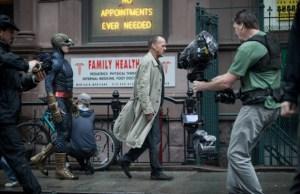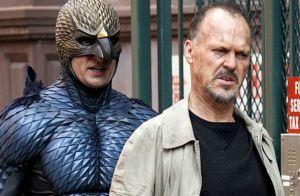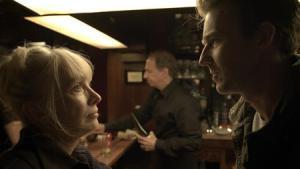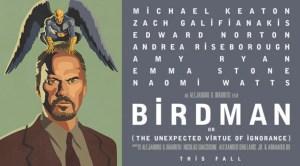It seems improbable that the Academy would go for a Black Swan-esque black comedy for Best Picture, but that's exactly what happened this weekend when Birdman took home Oscar's top prize along with Best Director, Original Screenplay, and Cinematography. In the film, Michael Keaton plays an actor (Riggan Thompson) once famous for a bird-themed superhero movie franchise he left behind only to flame out. On the downside of his career, he's been reduced to an ill-advised attempt to finance, direct, write, and star in a Broadway stage adaptation of Raymond Carver's What We Talk About When We Talk About Love. It is the type of film which one person can praise, with no trace of hyperbole, as being "What we talk about when we talk about movie magic" and another person can muster little more than a confused, "I just don't get it." It first came out in theaters months ago, and is now on home video. Many are likely seeing it for the first time right around now due to its new Best Picture notoriety. You're probably going to walk away with a lot of questions about what you see. Here are some of the answers, straight from the mouths of the people who made the film:
SPOILERS AHEAD...DUH 1. What's with the whole one-shot concept?  Move over Goodfellas. Step aside Boogie Nights. Your various Steadicam sequences are still amazing, but they're all still no longer than 3 minutes long a piece. Birdman utilized both Steadicam and handheld cameras to give the impression the film is actually a continuous take stretched across two hours. It's not, but it is still quite a technical achievement. The question, though, is what purpose does that actually serve to the film's story? Not everyone really understands the point of it all, with one Oscar voter telling THR, "People are obsessed with the single-shot concept, but it wasn't my cup of tea - it's like, big fuckin' deal." Thankfully, Elvis Mitchell of KCRW's The Treatment got a chance to ask director Alejandro Gonzalez Inarritu what the big f'n deal was:
Move over Goodfellas. Step aside Boogie Nights. Your various Steadicam sequences are still amazing, but they're all still no longer than 3 minutes long a piece. Birdman utilized both Steadicam and handheld cameras to give the impression the film is actually a continuous take stretched across two hours. It's not, but it is still quite a technical achievement. The question, though, is what purpose does that actually serve to the film's story? Not everyone really understands the point of it all, with one Oscar voter telling THR, "People are obsessed with the single-shot concept, but it wasn't my cup of tea - it's like, big fuckin' deal." Thankfully, Elvis Mitchell of KCRW's The Treatment got a chance to ask director Alejandro Gonzalez Inarritu what the big f'n deal was:
The moment I knew it was about the ego and some voice torturing a poor creature [Michael Keaton's character is taunted throughout the film by a voice inside his head which sounds like the super hero character he used to play] I knew that it has to be told not optically. In a way, it has to be a much more subjective experience to understand that voice is coming from inside you in a way, not observing the character but living through his mind. So, in a way that one continuous shot from his point of view is trying to get in his mind. It was like an extension of his state of mind, that shift from reality to his own fears and delusional thoughts. To really not just understand them but to feel them we have to be inside it. I knew that was the only way to do it.
2. Okay, it's not actually all one-shot, but how did they pull it off?  There are strategic, invisible cuts throughout Birdman meaning it was not filmed in one uninterrupted take but instead filmed as a series of long, uninterrupted takes, intricately planned and coordinated with tape markers on the sound stage very precisely directing the action of the crew and actors. To put that into context, Paul Thomas Anderon's three minute opening of Boogie Nights took 12 hours to film; Birdman had just 28 days to realize all of its shots, which adds up to a two hour film. Even today, Michael Keaton and Inarritu look back at it and joke they have no idea how they pulled it off. According to the editors, I narritu often used mirrors on set to help propel the illusion of everything occuring in a single take. They told MovieMaker.com that Birdman was unlike anything any editor would normally work on, "You're giving up control to the actors to a certain extent. Yes, there were still lots of ways that we could make adjustments and fine-tune, but we all signed on to this committing to the idea that this was all happening live."
There are strategic, invisible cuts throughout Birdman meaning it was not filmed in one uninterrupted take but instead filmed as a series of long, uninterrupted takes, intricately planned and coordinated with tape markers on the sound stage very precisely directing the action of the crew and actors. To put that into context, Paul Thomas Anderon's three minute opening of Boogie Nights took 12 hours to film; Birdman had just 28 days to realize all of its shots, which adds up to a two hour film. Even today, Michael Keaton and Inarritu look back at it and joke they have no idea how they pulled it off. According to the editors, I narritu often used mirrors on set to help propel the illusion of everything occuring in a single take. They told MovieMaker.com that Birdman was unlike anything any editor would normally work on, "You're giving up control to the actors to a certain extent. Yes, there were still lots of ways that we could make adjustments and fine-tune, but we all signed on to this committing to the idea that this was all happening live."
What they didn't say is just how much Birdman was secretly dependent on visual effects. According to Jordan Soles of Rodeo FX,, "Alejandro would prefer different performance takes from different actors, so it was not just stitching takes together but stitching performances, in some cases morphing heads and torsos." Wait, what? For example, in one scene Inarritu liked Michael Keaton's performance in one take but Edward Norton's performance in a different take. So, when the camera pans from Keaton to Norton Rodeo FX seamlessly switched takes. "[Norton's take] was framed a little different so we re-created some of the stage and [theater] seating in CG."
Rodeo FX estimates they did this type of thing around 100 times throughout the film. They were additionally responsible for slowing down or speeding up the film at certain points to make sure the shots matched up with the drum beats in the score, and they handled more traditional visual effects work like making it appear Keaton's character was flying or imagining that the city was under attack by comic book movie monsters. All told, 90 minutes of the film had to go through visual effects.
3. What's with the comet at the beginning? And the dead jelly fish at the end?There are only a few instances in Birdman which abandon the one-shot philosophy, coming at the very beginning (open on a comet soaring through the sky) and near the end (a mish-mash of shots of the comet and dead jelly fish on a beach while people in store-bought superhero costumes fight in slow-motion on the stage). You can interpret all of that however you want, but if you have no idea what to make of it Inarritu explained his reasoning to Elvis Mitchell:
4. Does he die or not? Just give me a straight answer.I saw some comets in some videos and some images. I began to understand something that I was feeling, but was not able to articulate in words in the script or something that was attached narrative. For me, I thought the comet was basically a way of saying without saying the state of mind of this guy. He was on fire, he was inspired, he was flying as a superhero, as a star. But the most inspiring part for me was when I discovered the dead jelly fish at the end. That's exactly who this guy is. He is a guy who one hour he feels like a comet on fire, and 30 minutes later he feel like a dead jellyfish. That's his life.
Birdman uses magical realism throughout its story to make it appear as if Riggan Thompson might in fact have powers like his Birdman character, floating in mid-air, using telepathy to hurl objects across his dressing room, literally flying above New York, etc. The film usually provides counterpoints to those moments of magical realism, e.g., Zach Galifanakis interrupting Thompson very clearly simply using his hands to destroy his dressing room, an angry taxi driver storming after Thompson thus indicating his flight above New York was really just him riding in a taxi.
There is not counterpoint at the end, though. Thompson shoots his nose off on stage, people love him for it (because they think it was an accident), and his career comeback is finally in full swing. As per the Raymond Carver quote which precedes the film, Thompson can now call himself beloved and feel beloved on the Earth. Of course, the cost of it all is that with his surgically reconstructed nose he literally can't smell the flowers his daughter (Emma Stone) brings to him at the hospital.
 As she leaves to fetch a vase for the flowers, he removes his bandages, looks at himself in the mirror, says goodbye to the Birdman persona haunting him, and approaches the window in his room. He opens it, takes a deep breath, and jumps out. When his daughter returns to the empty room, she searches for him before running to the window terrified before slowly looking up at the sky and smiling, presumably looking up at her father flying.
As she leaves to fetch a vase for the flowers, he removes his bandages, looks at himself in the mirror, says goodbye to the Birdman persona haunting him, and approaches the window in his room. He opens it, takes a deep breath, and jumps out. When his daughter returns to the empty room, she searches for him before running to the window terrified before slowly looking up at the sky and smiling, presumably looking up at her father flying.
The end.
What the hell just happened? Did he kill himself or not? Does he have magical powers or not? That's up to you to decide. Birdman's cinematographer Emmanuel Lubezki told The Treatment
5. Was there ever supposed to be any other ending?I love in Alejandro's work the ambiguity of all these images. In America, a lot of people get almost upset, "What is it? Why is it not explained?" I can't tell you how many people approach me, "Can you explain? Is he dead, is he not dead? I just love these images are almost poetic approach to the storytelling that don't really explain but make you feel something. They create emotions. I think that is almost more important than explaining and being too literal about certain things.
 Yes, and it was supposed to involve Johnny Depp. Birdman's co-screenwriter Alexander Dinelaris told the podcast Q&A With Jeff Goldsmith after Riggan Thompson uses a real gun to shoot himself on stage the camera would have swung around to see the audience cheering. The camera would have swung back around to the stage with a seamless time jump showing Riggan conducting a Q&A about his career and his play's incredible New York Times review:
Yes, and it was supposed to involve Johnny Depp. Birdman's co-screenwriter Alexander Dinelaris told the podcast Q&A With Jeff Goldsmith after Riggan Thompson uses a real gun to shoot himself on stage the camera would have swung around to see the audience cheering. The camera would have swung back around to the stage with a seamless time jump showing Riggan conducting a Q&A about his career and his play's incredible New York Times review:
Then the camera prowled like it did the whole film, went back stage through the halls we've seen the whole time and we'd get to the dressing room where literally Johnny Depp would be sitting looking in the mirror and putting on his Riggan Thomson wig and then the poster of Pirates of the Caribbean 5 would be in the back. In Jack Sparrow's voice [the inner monologue would say], 'What the fuck are we doing here, mate?' It was going to be the satire of the endless loop of that.
But Johnny Depp said no.
6. What about that scene with the New York Times critic? Were they just trying to get back at critics? If there is a traditional antagonist in Birdman, it is a New York Times critic whose opinion can make or break a play. She pledges to tear down Riggan Thompson's play before she's ever seen it because she hates everything he represents as a Hollywood whore wasting everyone's time on Broadway. He responds by pretty much throwing every cliché you can at a critic, e.g., "Who are you to judge? You don't actually risk anything! You're not an artist!" To some, it comes off as a transparent exercise in the filmmakers working through their own issues with critics. One of the co-screenwriters, Alexander Dinelaris, just happens to be an actual playwright. He swears there's more to it than that, telling Deadline:
If there is a traditional antagonist in Birdman, it is a New York Times critic whose opinion can make or break a play. She pledges to tear down Riggan Thompson's play before she's ever seen it because she hates everything he represents as a Hollywood whore wasting everyone's time on Broadway. He responds by pretty much throwing every cliché you can at a critic, e.g., "Who are you to judge? You don't actually risk anything! You're not an artist!" To some, it comes off as a transparent exercise in the filmmakers working through their own issues with critics. One of the co-screenwriters, Alexander Dinelaris, just happens to be an actual playwright. He swears there's more to it than that, telling Deadline:
The critic makes a really good argument about the movie business being a place where they are handing each other awards for cartoons and pornography, where they take themselves too seriously and think they can do everything. On the other hand, Michael says to that critic, you sit there behind your wall, where you are safe and you risk nothing. Everybody's got an argument, everybody takes their lumps. So I'd like to think that it's not just a vendetta there [...] We watched these critics talking about how they loved the movie, but said the one thing they couldn't believe was that the critic prejudging the play, that could never happen. I'm thinking, so this film starts with a man, floating in the air in his underwear, and that's the one thing you couldn't believe? Everybody gets hung up on that part, with the critic.
7. Why did they give it that pretentious sounding subtitle: "Or the Unexpected Virtue of Ignorance"?
 Everytime Birdman's full title ( Birdman Or The Unexpected Virtue of Ignorance) was said out loud during the Oscar telecast a thousand people live-tweeting their viewing experience cracked a snarky joke about how pretentious it sounded. Or at least that describes what I personally observed on Twitter during the telecast. So, seriously, why did they add that subtitle? According to Inarritu:
Everytime Birdman's full title ( Birdman Or The Unexpected Virtue of Ignorance) was said out loud during the Oscar telecast a thousand people live-tweeting their viewing experience cracked a snarky joke about how pretentious it sounded. Or at least that describes what I personally observed on Twitter during the telecast. So, seriously, why did they add that subtitle? According to Inarritu:
8. Should it really have won Best Picture?That subtitle came later. What happens to this character is, he is an actor and to be most successful, he has to be not himself. That is the most incredible set of contradictions, the idea that you have to be not yourself in order to be good. In the moment that Riggin Thompson tries pretentiously and ignorantly to prove he is something that he is not, when he surrenders to that, when the critic says I will kill you, when his daughter rejects him and he realizes he has lost everything, in that moment right before that climactic act onstage, he is not acting. He is real and that is why the critic responded to his performance. He broke the rules of the game. And by surrendering to his reality, he gets to the unexpected virtue of ignorance. There was beauty in it.
 Birdman could now be referred to as Birdman Or the Rather Expected Burden of Winning Best Picture. It now has that stamp of Oscar approval on it which makes it that much easier to want to tear it down, many arguing Birdman will be forgotten and Boyhood remembered as the true classic. There are also many who flat out hate Birdman, most notably Howard Stern, "I thought Birdman was the biggest piece of shit... I thought it was pretentious. Listen, I've seen movies about acting, especially about Broadway - A Chorus Line, All That Jazz - that handled this subject so much better. I think it gets these accolades because actors love to see shit about actors." But how much stock do you put into anything Howard Stern says anymore?
Birdman could now be referred to as Birdman Or the Rather Expected Burden of Winning Best Picture. It now has that stamp of Oscar approval on it which makes it that much easier to want to tear it down, many arguing Birdman will be forgotten and Boyhood remembered as the true classic. There are also many who flat out hate Birdman, most notably Howard Stern, "I thought Birdman was the biggest piece of shit... I thought it was pretentious. Listen, I've seen movies about acting, especially about Broadway - A Chorus Line, All That Jazz - that handled this subject so much better. I think it gets these accolades because actors love to see shit about actors." But how much stock do you put into anything Howard Stern says anymore?
As always, time will be the real judge. Remember what Alejandro Inarritu said when he accepted the Oscar for Best Director:
For someone to win, someone has to lose. But the paradox is that true art, true individual expression can't be compared, can't be labeled, can't be defeated because its victory is that its exists. Our work will be judged, as always, by time.

